Traffic Improvements. There – I’ll say it again, in case you missed it. “Traffic Improvements.” Just exactly do you take that to mean? I ask because, of course, different people mean different things when they say “Improvements.”
It’s interesting to me – because my vision of traffic improvements is evidently not quite the same as the traffic improvements planned by NZTA. Maybe that’s predictable, or maybe not, but I’ve been wondering what NZTA had in mind for the Inner City Bypass (or ICB, as they like to say). A couple of years ago, when the NZTA were first talking about the Basin Bridge / Concrete Flyover etc, one of the side comments that they muttered under their breath was “and of course we’ll be spending a small amount of money doing some traffic improvements to the existing ICB”. And now they’re doing those small things, and now at last we find out what they are.
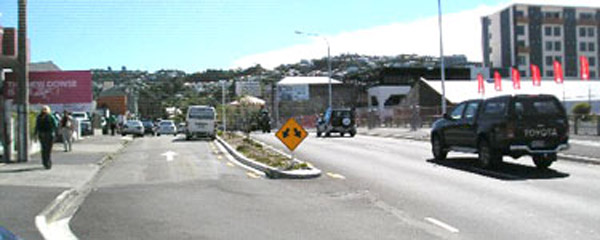
Essentially, the “traffic improvements” to the ICB involve adding an extra lane, essentially everywhere. Where it was 3 lanes (at the junction of the Terrace Tunnel at Willis St) it is now 4 lanes. Where it was 2 lanes (along Karo Drive) it is now becoming 3 lanes. Kerb and channel that has only been there since mid 2000s is now being torn up, along with flower beds and any of the other slight attempts at landscaping that Transit made at the time, and extra asphalt is being added. Traffic improvements evidently do not seem to include things like dedicated bus lanes in the new lane of traffic, or a new cycle lane, or even a widened pedestrian pathway, but all it seems to be is just an extra lane of traffic. Ooh, yes, and a monstrous great concrete gun-emplacement of a concrete wall at the junction of Willis St and Abel Smith St. I think there will be a plant there one day – for now, it is only dirt and concrete.
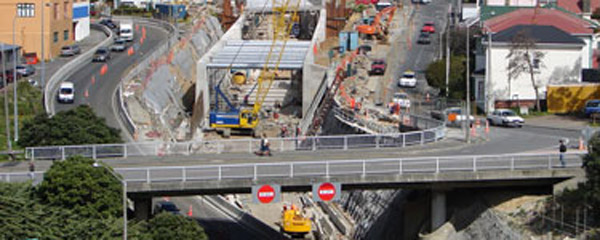
The reason I bring this up, is that there are some new “Traffic Improvements” being planned for Vivian St, as part of the round the Basin works, or the Basin Bridge works, if indeed there is a difference between those. Vivian St is essentially being planned to go from 2 lanes to – yes, you guessed right – to 3 lanes, at the bottom part of it first. So, parking in front of the last block between Tory St and Cambridge Tce will be removed – i think it applies not just at peak time, but perhaps all day long? After all, for Vivian St, as part of the State Highway 1, it never really has a period when it is not busy. Vivian St is, essentially, a controlling factor in the flow of cars into the city. It is only 2 lanes wide at the start, and it is arguable that it only needs to be 2 lanes wide at the finish as well. Certainly if it was 3 lanes all the way through, from top to bottom, then Vivian St would become a defacto motorway extension. Currently, some of the drivers using Vivian St treat it like a motorway anyway – I’ve seen and heard some pretty hairy close misses from people still tuned to the speed they were doing on the motorway, and rather oblivious that they are passing at ground level through one of the most densely packed pedestrian routes in the city, as they zoom across Cuba St. At present, the somewhat ridiculous weaving back and forth (necessitated by small pockets of parking on one side of the road, that then swaps to the other side), is not, as I have thought in the past, merely incompetence by the traffic designers at NZTA, but instead it is actively planned that way, to emphasize the weaving, and thereby slow down the speed of the cars cruising through.
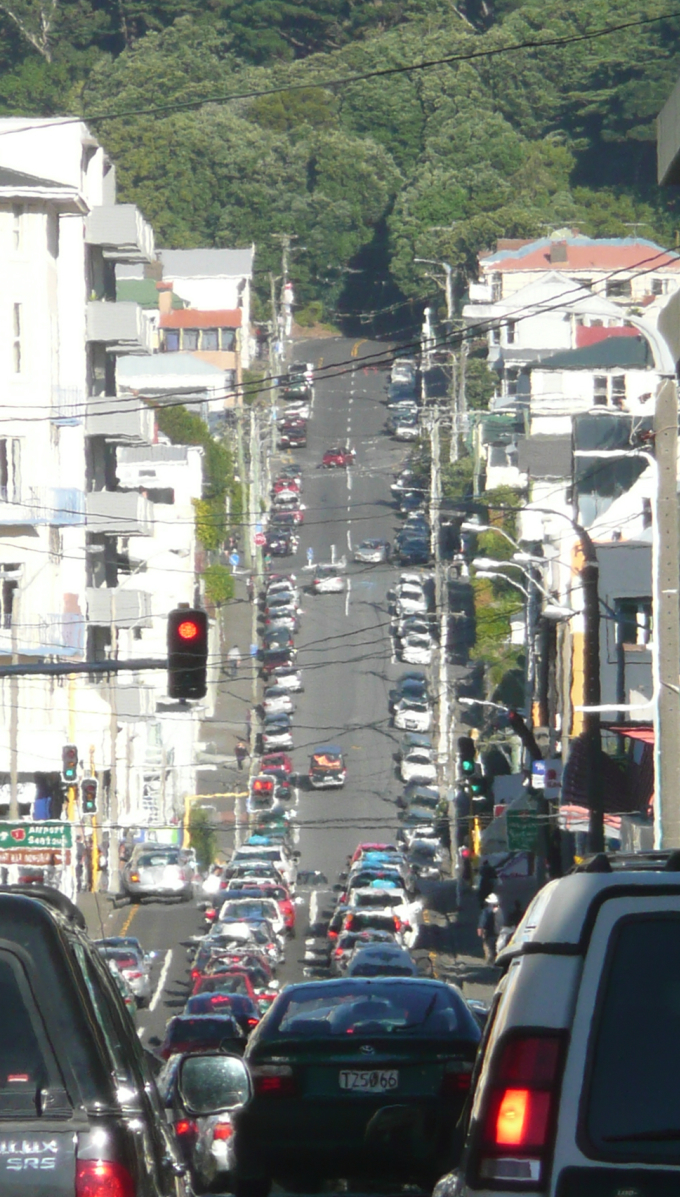
The Basin Bridge Inquiry is proving fascinating though, for all the worms coming out of the skeletons in the closet. SO many closets. So many skeletons. So many worms. The traffic planner acting for the Save the Basin team, John Foster, sounds like a absolute hoot – he’s a crochetty old bugger who is as smart as a tack, and won’t be bullied into signing NZTA simulations. Have you been following all this? There is (unintended?) hilarity in the driest of possible dry ways here, but Foster has been really opening some eyes for me, and I suspect opening a few of the judges as well. First up, here’s a typical snippet of dialog:
MR CAMERON: Okay, so as I understand it Mr Foster in terms of your career which has spanned many years now, you for example have been engaged in advice and work in relation to for example the ICB weren’t you?
MR FOSTER: Yes.
MR CAMERON: And I think were in part responsible for the outcome that’s been achieved through that particular upgrade to Wellington’s road or strategic road.
MR FOSTER: I’m not sure that I’m with you, but carry on.
MR CAMERON: Well, you gave advice in relation to the development of the ICB didn’t you?
MR FOSTER: Yes. I did the scheming studies.
MR CAMERON: Yes.
CHAIRPERSON: Sorry, you did the what?
MR FOSTER: The scheming studies. Which then gets approval and a detailed design was done by Opus and then the traffic design group was re-employed during the hearings before the Environment Court.
MR CAMERON: Yes so you’re well familiar with all of the background work that was done in relation to that.
MR FOSTER: Yes.
MR CAMERON: And you’ve of course been involved in the – sorry?
MR FOSTER: The Basin Reserve didn’t figure in that.
MR CAMERON: No, I wasn’t suggesting it did.
MR FOSTER: Okay, sorry. I was having some difficulty.
MR CAMERON: Don’t leap in. We’ll get there. Okay.
MR FOSTER: I wasn’t in the same paddock, it’s all right.
MR CAMERON: It’s okay, we’ll get there. And it would be fair to say that over the many years of your career you’ve listened to and no doubt participated in the longstanding conversations that have occurred regarding the Basin Reserve?
MR FOSTER: No, not really. My direct contact with the Basin Reserve as a traffic facility was only recently….

So, there is lots of mis-hearings, and pauses for people to find the right paragraph etc, but there are also some real gems being brought out of the NZTA closet. Take a close look at this, from about day 21 of the proceedings:
MR CAMERON: So your view at the moment is that the conflict that others consider to be of such concern is not an issue for BRT?
MR FOSTER: Of course it is. The problem is not the conflict between the buses and the relatively small and disciplined pulses of traffic going across state highway 1. The conflict is between the buses and the other users. Buses and the others users, the cyclists and the pedestrians and the general traffic, must stay on the Basin Reserve. They must be controlled with two traffic signals at those intersections. And whether or not Option A or Option B is better or not depends on how that is done. The problem you got with buses is that they – and their biggest and worst conflict is with the people who ride in them. Pedestrians.
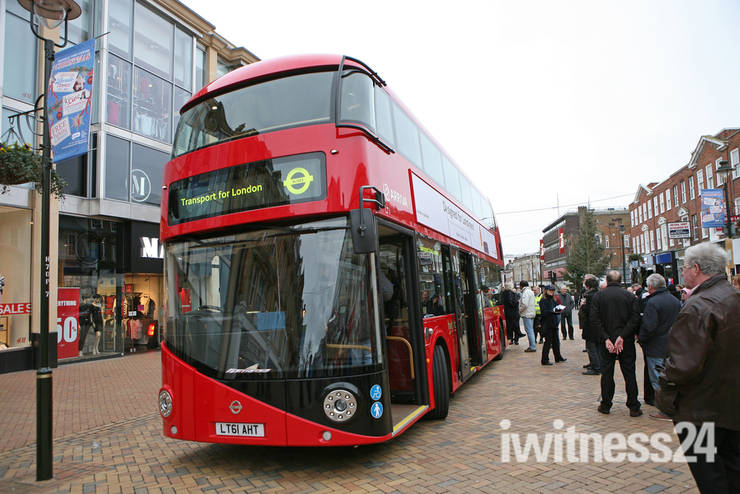
Related to that is this little gem:
MR BENNION: Thank you Mr Foster. The Board’s indicating that they’ve understood that from your evidence and it’s my mistake for going there. Can I just ask you then one last question before I leave you to questions from my friends. And let me ask this carefully in light of what’s been occurring through the day. There’s been some criticism of the BRREO concept and whether it could handle bus rapid transit. In very general terms do you have a comment about the BRREO concept that you’ve examined and its potential to deal with bus rapid transit?
MR FOSTER: Well I can start by saying I’ve examined the BRREO concept thoroughly in its ability to handle the current bus situation. And my conclusion is it does it just about as well as the proposal tabled by the applicant. I have not examined it in relation to rapid bus transit. I’m not at all sure whether I know what is meant by that term. I don’t know what the vehicles look like. I don’t know their acceleration and deceleration characteristics. I don’t know how many doors they have and how many people can get out and in in 10 seconds etcetera etcetera.
I’m not even sure which routes they’re on so I’m absolutely incapable of giving you any serious advice about how either proposal will work under those conditions. That would require a considerable amount of work. Moreover it would require models of much more sophistication than those currently available to NZTA.
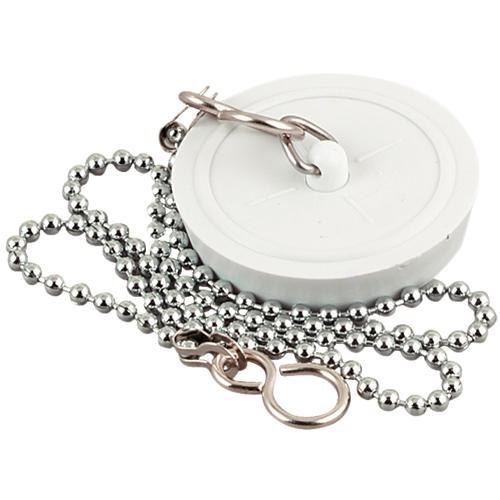
So those little bits of dialog made me understand how critical the traffic planning is balanced. Foster carefully explained that there were two key “plugs” to stop the city filling up with traffic. On one side, the Terrace Tunnel stops too much traffic coming INTO the city from the north and west. As he said, we don’t know what the traffic will do if we duplicate the capacity for letting more traffic into the city. Instant clogging up of the arteries, I would have thought, and, as Sutch said, a Sick City entails – it is one of the key reasons why Auckland is not getting any better, despite all the new roads they are building. Build more roads, get more cars, clog more city. The other plug is of course the area around the Basin Reserve – the Mt Vic tunnel, the Basin itself, the Taranaki St intersection – all of those create a plug that slows the rate of traffic exiting out of the city. Of course, as Foster says, NZTA’s modelling does not work at a fine enough level of detail to know what is really going to happen when we open the floodgates in and out of the city. It’s increasingly clear that NZTA have not done the modeling with regard to the BRT proposal (and nor should they have, as it has only been announced in the last week or so), but that things as important as loading times depend on things as mundane as ticketing systems.

Arguably, all this work to the SH1 at Vivian St should not happen at all, and if it does, it should only happen underground. A trench. I think we need to start exploring the concept for a trench at least in parts along Vivian St, as 3 lanes at ground level there is just going to be horrific. Got any good suggestions of tunnel integration with the street that I can post up here? Feel free to comment, and we’ll see what we can cobble together.




To trench or not to trench, that is the question.
Whichever way such shallow sunderings saunter, keep in mind that the closer one gets to Kent and Cambridge, the closer one gets to the high tide mark and tunnelling under water is a whole lotta money.If you think flyovers are expensive, underwater tunnels are another thing entirely
I was always told that the Basin was meant to be a shipyard with Kent and Cambridge as canals to and from it until the ’55 quake raised everything – anyone know more about that or am I just threadjacking? (sorry Max)
Replug crazy idea: the deep bore tunnel concept. Bypass the city entirely. Leave Mt Vic Tunnel at current capacity to control amount of traffic entering city. Ditto with traffic coming out of Tce Tunnel.
Otherwise any plan to put eastbound traffic underground in a cut-and-cover I suspect will (should) be alongside the route of the existing ICB. Trenching Vivian St while it’s in use as SH1 would be impossible.
60 – you are correct about the waterway – there were plans for the Basin to be dredged and provide Wellington with a safe harbour – hell, I’ve just realized that the name means somewhere full of water. The 1855? Earthquake certainly put a plug into that scheme though, as the whole of Wellington came up about 2-3 m in that quake, and so the Basin no longer drained properly. But I suspect it was never going to work then anyway – remember that the ships around in those days were sailing boats, and I really don’t rate their chances of being able to tack back and forth in that narrow area in the face of a stiff Wellington nor wester…
But what is being thought of at the bottom of Vivian is not a tunnel, but a bridge. All the traffic planners are ignoring it, but I suspect they all know that a bridge / flyover over Cambridge and Kent will be the only way long term, if traffic continues to grow. Of course, with news just out today that cycling is up 73% and car driving down 3.5% then that puts it in the too hard / far away basket, but still, long term, I believe an over bridge will be sought.
Erentz’s suggestion of a deep bore tunnel, while sensible in terms of traffic flowing logic, will never gain enough momentum due to cost. But trenching could be done quite simply. After all, it was only a few years ago that traffic went down Ghuznee St on SH1. NZTA could easily rediveert the traffic flow down Ghuznee while they dug out Vivian for a year or two. That’s one of the main reasons that NZTA have refused to sell the land at the top of Ghuznee for a park – because, putting it bluntly, they know they will need to use that land again.
Ah that all makes sense Max – that swingarm made of Armco on the South side of the terrace tunnel looks ready to divert traffic flow at a moments notice
Perhaps the rise and fall of the twisting tail of SH1 coursing through Te Aro streets will in time come to be known as our traffic taniwha?
60 – you’re getting very fruity and poetic today, there must be something in your cornflakes – but yes, it’s time to think about the twisting and turning. As far as I can tell, the current road levels are set up so that, should the option be taken to trench instead of cross at grade, a switch can be easily made at certain points. Presumably, when the ICB was being planned, both options were on the table until quite late, and then one was chosen ie At Grade. In theory, that lets the traffic freely intermingle, whereas in actual fact, it lets the traffic snarl up. The good thing about that is, of course, that when the traffic is snarled up, the pedestrians can cross freely amongst them.
The crossing at Cuba St is a good example. Traffic on SH1 has a long long period of green light through there, and as the main pedestrian crossing N-S, Cuba gets pretty antsy about having to wait. When the traffic is flowing fast, you’re dicing with death to try and cross, but many do. But then when it contests badly at peak hour (currently which seems to extend from about 4-7pm) the road is easy to cross, with people threading their way through the “parked” cars on the road. But is that really a very satisfactory solution? Shouldn’t there be at least ONE crossing N-S that can be taken by cars and pedestrians without having to wait for lights? While for car-traffic reasons (ie people driving down from Brooklyn) that would seem to be Victoria or Willis, for Pedestrian reasons, that should obviously be Cuba. Yes? No?
“will never gain enough momentum due to cost”
I agree. I don’t even think it’s cost, I think it just is too radical it provokes the crackpot-idea center in peoples brains. I’d still love to see a serious analysis of it though, total package of one versus total package of the other remembering the costs of the duplicate Mt Vic tunnel/Tce Tunnel, and eventual trenching of Vivian St/ICB are not cheap either. NZTA said the cost of the tunneling works for Waterview in Auckland was around $500 million (which is peanuts and sounds wrong to me), but even the total project is $1.5 billion, which isn’t far off what will eventually be spent in Wellington I’m sure. Granted it may cost more in Wellington, but it’s worth finding out IMO.
“that swingarm made of Armco on the South side of the terrace tunnel looks ready to divert traffic flow at a moments notice”
At the time of the ICB the explanation given for retaining this (which used to be the old off-ramp onto Ghuznee) was for “emergency access”.
Actually its not even Emergency Access – they use that space quite regularly for parking trucks etc on, when they are doing work to the Terrace Tunnel and the ICB.
There was a proposal (i forget by who) a few years ago, that this dead end section of roading should be given back to the city for a park (by St Peters) but the NZTA just flatly said no, even for short term park use, so it is clear they plan to keep using it for roading purposes.
Those dreadful, long waiting time pedestrian crossings across Vivian St and Karo Drive could be cheaply fixed with some pedestrian subways. Cuba and Willis need them badly.
I know, they are perceived as unsafe these days. If people don’t want to use them, they can always continue to wait and wait and wait at the lights….
Thank you Max for all that dredging through all those documents.
Whilst fuel prices are rising and car usage is falling any sensible solution should entail proper analysis of public transport and a decent pause to see what is really necessary as regards roading in Wellington. Auckland is stuck in their cars because the public transport is so poor. Wellington could revamp their system. If all this money is wasted on unnecessary roads how will we fund public transport adequately when it’s need becomes obvious even to these dinosaur traffic planners. They couldn’t go to London and say “hey look what we did in NZ” They would be shown the door!
To back up Elaine’s comment, the MoT’s new stategy director, seconded from the University of the West of England in Bristol, said at a seminar at Otago Uni in Newtown last week that when taken on a tour of Auckland he was “shocked” by the scale of urban road building there (presumably Waterview). He did then comment about completing the network etc.
As an aside, funny how completing networks is something that is required just for state highways, and such completion always needs just another project or two…